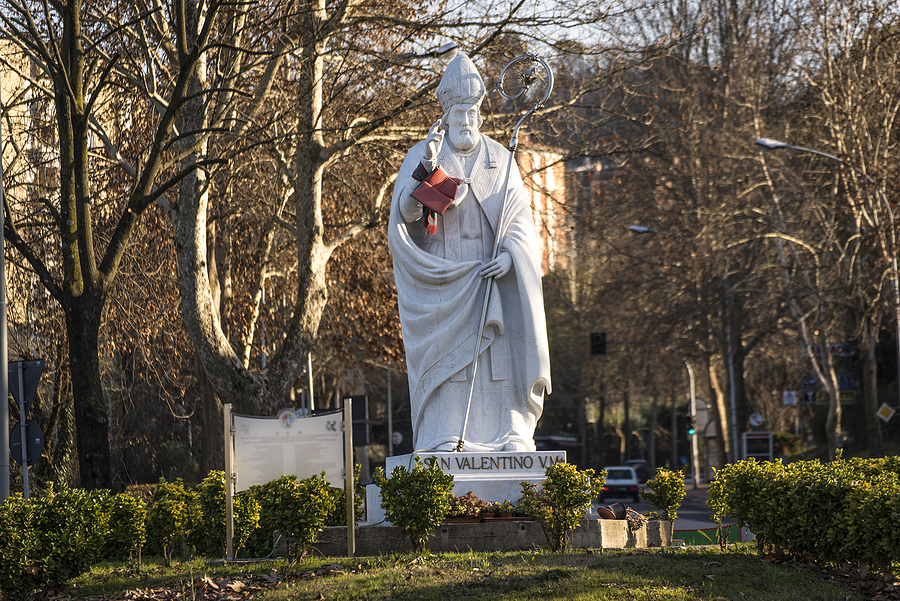By Luisa Pastore and Silvia Donati
Type 'Saint Valentine' into any Internet search engine, and among the thousands of websites selling flowers, chocolates and greetings cards, you’ll find just a handful dedicated to the saint himself.
Browse these for a few minutes, and you’ll discover that not only do we know very little about his life, but that there are in fact two different Valentines vying for the title of ‘Patron Saint of Love:’ Valentino di Roma and Valentino di Terni.
Who Was San Valentino?
Valentine of Rome is said to have been a priest during the bloody reign of Emperor Claudius III, also known as Claudius the Cruel. Due to the number of military campaigns the emperor carried out, he was in constant need of young men for the empire’s army. He thus decided to outlaw marriage between young couples; he reasoned that unwed young men would make better soldiers because they wouldn’t be attached to their wives and families. Valentine refused to abide by the decree and continued to officiate weddings in secret. Eventually, he was discovered and sentenced to death (by way of being beaten to death with clubs and having his head cut off, no less).
While in prison awaiting execution, Valentine had befriended the jailer’s daughter; the two fell in love, and before his death, he sent her a letter, signed, of course, ‘from your Valentine.’
The other Valentine was the Bishop of Terni, a city in Southern Umbria close to the Flaminian Way. A well-loved miracle worker, he was summoned to Rome to cure the child of a prominent Roman official, and subsequently the Roman’s whole family converted to Christianity, as did three Greek scholars. After Valentine’s execution (he was tortured and, like Valentine of Rome, beheaded), the three men transported his body to Terni, where it was interred in what are now the outskirts of the modern city.
Both men are said to have been killed for their faith on 14th February around 270 AD along the Flaminian Way, although at different points. Unsurprisingly, while some scholars maintain that they were two different people, many claim that the similarities between the two figures are too significant to be dismissed as mere coincidences, and there only ever existed one real Valentine.
Perhaps the most significant study on the subject, San Valentino di Roma or di Terni, was published by the priest and scholar Padre Agostino Amore in 1966. In it, he concludes that the only martyred Valentine was the one from Terni, a view supported by the fact that Valentine, Bishop of Terni, was the only Saint Valentine to be included in all the oldest martyrologies. Further evidence for his existence came to light in 1927 when, during roadworks close to his supposed burial place, laborers uncovered marble fragments from a Christian martyr’s tomb.

Why Is San Valentino a Symbol of Love?
A theory about Valentine’s link with love and romance centers on the fact that his feast day fell during the Roman Lupercalia, when youths drew girls’ names at random and these new couples participated together in sexual game-playing. Christian priests replaced the old Pagan festivals with feasts dedicated to the saints, although the feast of Saint Valentine was less popular than the old hedonistic festival. As a compromise, priests declared 14th February a feast of love, but of romance rather than lust.
According to another legend, Valentine cultivated a beautiful garden, and gave his roses to young members of his congregation. When one young couple fell in love, others began to visit the bishop in the hope that they too could find happiness. His blessings were so popular that he had to designate one day a year to blessing marriages, and thus he became known as the patron of lovers.
Some sources say that he was also the first person to conduct a wedding between a Christian and a Pagan: Serapia, a local girl, and Sabino, a Roman soldier. Sabino converted to Christianity, but his young bride fell ill and died not long after. Consumed by grief, Sabino visited Valentine for help, and after praying with the bishop, he was able to enter heaven to be with his beloved.
During the Middle Ages, the cult of Saint Valentine spread beyond Italy, to Central and Northern Europe, where many of the traditions associated with the modern Saint Valentine’s Day originated. In Italy, meanwhile, evidence of his great popularity can be found in the many churches, villages and towns named for the saint which are found all over the country.
Valentine’s Day in Italy
A recurrent object used to celebrate Valentine's Day in Italy is the orange; it is not uncommon to see whole villages or statues decorated with oranges on the feast day. A famous celebration takes place in Quero, near Bolzano, where oranges are blessed and then thrown down a slope near the church of San Valentino as a sign of good luck. In Vico del Gargano in Puglia, oranges are used to decorate the city and the statue of the saint, celebrated with a traditional procession.
Nowhere is Valentine more well-loved, however, than in his birthplace, Terni, of which he was named patron saint on 5th March 1644. Today Terni is Umbria’s first industrial center, where Roman ruins and medieval alleys jostle for space with modern shopping centers, apartment blocks and factories, many built since the Second World War when the city suffered heavy Allied bombing. Despite its historical heritage and its position close to the spectacular Roman-built Marmore Waterfalls, its (largely unwarranted) reputation as ‘The Manchester of Italy’ means that it is bypassed by many tourists.

Every year on the Sunday before February 14, engaged couples from all over Italy take part in a special mass at the Basilica di San Valentino in Terni, situated in the town's suburbs, on a low hill surrounded by tower blocks and scrubland. The couples exchange their vows in front of the tomb of Saint Valentine, which is said to contain his relics, placed under the main altar. Several places in Italy and Europe claim to house pieces of Valentine's body, as, in the past, it was customary for relics of saints to be distributed around. For example, the alleged skull of Saint Valentine is on display in the Basilica of Santa Maria in Cosmedin in Rome.
The site of the Basilica of San Valentino in Terni originally housed an oratory, and an ornate basilica was constructed in the 4th century right above the tomb of the martyred Saint Valentine, after Emperor Constantine ended the persecution of Christians. The current church, which dates back to 1618, is a simple white affair, a great contrast to the ornate basilica of that other world-famous Umbrian saint – Francis of Assisi.
But then what else could we expect from a saint whose life remains shrouded in mystery? Considering how little we know about Valentine himself, perhaps the only surprise should be that Saint Valentine’s Day is still celebrated across the world, 17 centuries after his death. While the saint himself has been all but forgotten, his message of love remains.
For further information about Terni, visit https://turismo.comune.terni.it/en.









